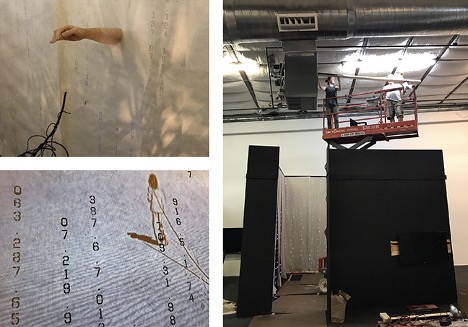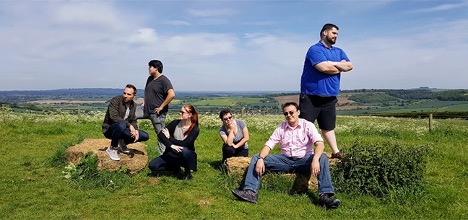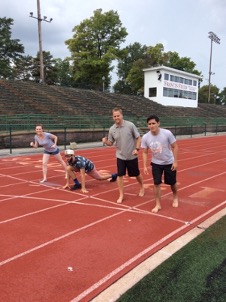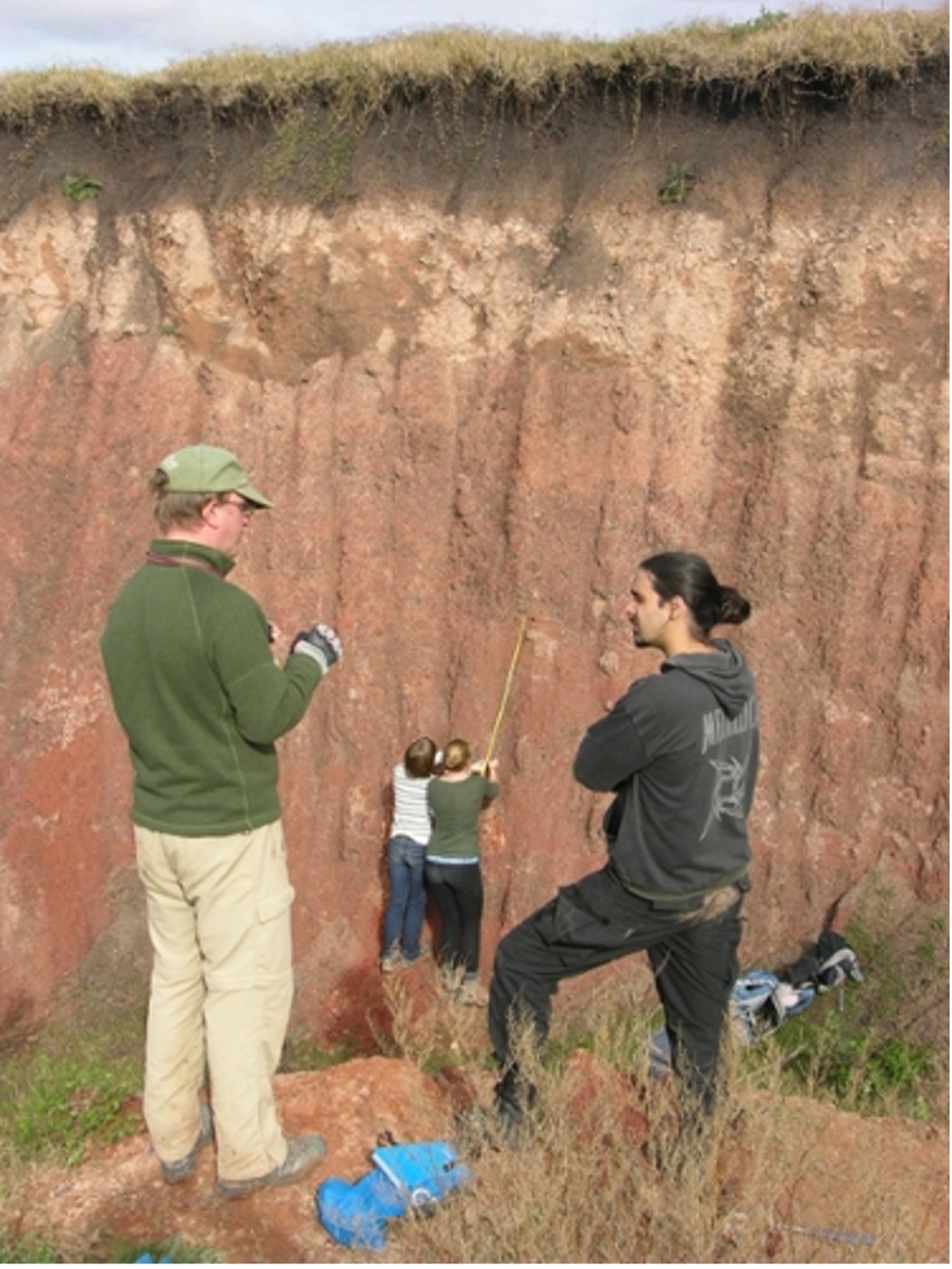Honors Research Institute (HRI)
The Honors College Research Institute (HRI) provides support to promote collaborations between honors faculty and students engaged in research in either scholarly or creative pursuits. Honors faculty from any field—humanities, social sciences, natural sciences, fine arts, and mathematics—may work work with 1-4 undergraduate students on a specific project related to their scholarly interests. By working with the honors faculty member, students will gain professional knowledge and skills by learning and practicing specific methodologies of investigation and research conducted in a field environment. These field activities may include data collection from a geologic location, to archival research in a library collection, to installing a visual art exhibit for public display. Research for HRI projects may include national or international travel as well as on-campus projects. As a final component of the project, students and faculty are expected to complete a final synthesis of their research in a professional format, such as a research paper or report. This work is encouraged to be presented at a conference or published.
Eligibility
HRI funds are limited to faculty members employed by the UNM Honors College, with preference given to those who hold the rank of Assistant Professor or above and have not received HRI funding in the last two years.
Funding Deadlines
- HRI expects to fund 2-3 grants for summer projects, each for $2,000-$3,000. Application deadline for summer HRI funding: March 15.
- HRI expects to fund 1-2 grants for fall projects, each for $2,000-$3,000. Application deadline for fall HRI funding: June 15.
- HRI expects to fund 1-2 grants for spring projects, each for $2,000-$3,000. Application deadline for spring HRI funding: September 15.
COMPLETE THE HONORS RESEARCH INSTITUTE APPLICATION ONLINE NOW.
Examples of Research Projects Supported by the Donors to the Honors Research Institute
Generous support from the Healy Foundation has supported Honors College Research Institute projects since 2017. In previous years, projects were funded by grants from Sonnet and Ian McKinnon, Lee Blaugrund, and several friends of the Honors College.

Spring 2023
Cyanograms: Shadows Cast on Ephemeral Futures is a photographic installation that uses large-scale photographic imagery to make visible students’ climate grief in a changing world. Drawn from interviews with UNM students about the climate crisis, students’ words were transformed into poems detailing their fears and hopes for the future. Paired with images of our local natural and built environments and silhouettes of students, these poems were printed digitally on fabric simulating the cyanotype photographic process. These large scale pieces were hung in in the Honors College Forum and remained on display during the National Poetry Month, Earth Day, and the UNM sustainability expo.
During the sustainability expo, our team talked with students about their climate fears. Using turmeric ink, students wrote down what they were afraid of losing on small slips of scrap paper. They then tied the scraps to a “solastalgia tree.” Solastalgia is a neologism describing the distress produced by the contemporary effects of climate change in one's home environment. As turmeric is light sensitive and fades over time, these words, too, faded, creating a visual representation of loss.
Summer 2022
In July 2022 two Honors students (Isabella Perea and Ian Hutchinson) accompanied Dr. Jason Moore for 9 days of fieldwork in the Paraguayan chaco. Our field crew of six, including two Paraguayan collaborators, visited three localities spanning the length of the Pilcomayo River from the Bolivian border to Asunción. At each locality, Bella and Ian surveyed and photographed the local environments and censused the modern bone assemblages found on the chaco surface for comparison with environments and fossils from the geological record. The similarities with our deep time field areas in the US were striking and we will be returning to Paraguay next year for a longer field season gathering data for more in-depth comparisons. We had an incredible welcome from everyone we met in Paraguay, built many friendships, and learnt a lot about Paraguayan culture and history. Interestingly, after much research before our arrival, our Paraguayan colleagues believe that we are the first Western paleontologists to have visited Paraguay!
Fall 2020
A map of a city can tell us how to get from place to another. As it does so, the map outlines what we will pass along the way: a topographical map might show us the mountain that stands between our goal and us; a Doppler map details the weather we’ll encounter along the way. To pin a poem to an intersection on a map is to pin a moment of time. Together, those moments start to build an understanding of Albuquerque that is larger and more complex than the map itself. It is a network of architecture and culture, language and nature, concrete details and local realities, history and lived experience—as well as the interactions that occur in the audience’s mind when two or more of these are juxtaposed. A map shows the relationship between two objects in space, but when those objects are poems, the audience participates in creating that relational link. Poetry of place values locales, knowing “who you are by knowing where you are,” as the poet Wendell Berry once wrote. Place-based poetry has the ability to create timeless moments, express individual experiences in a universal way, and craft a sense of communal identity. “Viewers are as much a part of the landscape as the boulders they stand on,” according to Leslie Marmon Silko. Or, as Maxine Kumin put it, “In a poem one can use the sense of place as an anchor for larger concerns, as a link between narrow details and global realities. Location is where we start from.”
Working with the Poetic Routes creator and Honors faculty member, Amaris Ketcham, and the City Planning Department, students assisted in organizing, marketing, and facilitating poetry workshops in diverse local communities. Poetic Routes is an interactive poetic cartography of Albuquerque, NM. This map, viewable at www.poeticroutes.com, pinpoints poems to the specific streets, buildings, or landmarks that either inspired the poem or are referenced in the lines. This project is an example of creative placemaking and how poetry of place can help local government understand the community character and values of different neighborhoods.
Students worked with the Long Range Planning Manager for the City Planning Department. This department had divided Albuquerque into twelve communities where, in the following years, they planned to conduct research on how community members view their neighborhoods and what they would like them to be. The City agreed that poetry could be a powerful tool to better understand the character and values of different neighborhoods. Students helped to develop, pilot, and run online poetry workshops on local traditions and place, mythologies and place, and ecopoetry in several of the communities as part of the city’s outreach.
Summer 2018
During Sumer 2018, Dr. Myrriah Gómez, two undergraduate Honors students, one UNM graduate student/Honors College alumnus, and Dr. Anna Nogar (also a UNM Honors Program alumnus) in Spanish and Portuguese began the Nuevomexicana/o Baby Boomers Oral History Project. With the generous support of the Honors Research Institute, Dr. Gómez was able to invite UNM Honors College students Kelsey Martin and Kathrine Ervin to participate in this project, which had already received summer funding for Dr. Gómez, Dr. Nogar, and Ms. Wiggins from the Center for Regional Studies. This project was conceived as an ethnographic research project focusing on the nuevomexicana/o population in New Mexico with a particular focus on the baby boomer generation. The project seeks to explore a specific generational population within an already negotiated ethnic group whose voices express the rich cultural heritage of New Mexico that imperiously needs to be documented and made accessible to both academic and non-academic audiences.
Working with Dr. Gómez, Katie and Kelsey were introduced to oral history research and witnessed the development of a large-scale qualitative research project. Throughout the month of June, Katie and Kelsey participated in discussions regarding revision of the project protocol and IRB process. They completed Collaborative Institutional Training Initiative (CITI) training in order to participate in human subject research. During July and early August, Katie and Kelsey helped conduct oral history interviews in Taos, Las Cruces, Santa Fe, and Española.
Summer 2018
In this fieldwork two HRI funded students joined me on a two week field sampling expedition to Toadstool Geologic Park in Nebraska. We collected samples of macro- and microvertebrate fossils from localities spanning the Eocene-Oligocene Climate Transition, the time period during which permanent ice first formed on Antarctica. This research provided the basis for three student poster presentations, and two research-focused Honors classes, so will have impacted the scientific community and a significant number of Honors undergraduates.
Summer and Fall 2017
The American Continental Divide is a both a notable geographic feature and a distinctly cultural construct. Students in this Honors Research Institute are studying (field work completed in Summer, analysis and write-up continuing through the Fall semester) first-hand the ways in which people—from prehistoric Native American big game hunters to early American explorers to modern trail hikers and tourists—have traveled, used, physically shaped, and intellectually defined the continent's spine.
In the summer of 2017, Dr. Troy Lovata and four students spent a week backpacking the National Scenic Continental Divide Trail to record first-hand the cultural overlay of the remains of prehistoric Native Americans, waves of explorers, the Divide's first tourist railroad, and today's long-distance through hikers. Their research focused on how people, from prehistory through present, travel and mark their place on the landscape. For this project, they recorded different types of trail use, examined arborglyphs, and studied how recreational trails overlay paths used by Native Americans and early American explorers and settlers. Research focused on Central Colorado, but students also spent time studying the trail outside Cuba, New Mexico—designated by the Continental Divide Trail Alliance as a Gateway City—in order to compare findings across the Rocky Mountains.
For the past 8 years the Center for Mountain and Plains Archaeology at Colorado State University under the auspices of Professor Jason Labelle has been studying the prehistoric archaeology-especially features related to game drives and high altitude occupation by big game hunters going back to Paleoindian times—of Rollins Pass, Colorado. They have also uncovered numerous historic era sites, including the remains of the first tourist train to the Divide, and noted that the Continental Divide National Scenic Trail overlays their research site. But they have not previously been able to fully study this more recent use of the landscape.
Dr. Lovata and his students were invited to do research at Rollins Pass that incorporated Dr. Lovata’s expertise in studying contemporary archaeology, exploring syncretic trails, and examining how the past is used by people today. This project provided Honors students the opportunity to learn not only about these topics, but also to study the remains of prehistoric Native Americans and learn about mapping and survey skills.
Experiential Art Installation Presented at Currents New Media
Summer 2017
During the summer of 2017, Professor Megan Jacobs, UNM Honors College student Madelyn Lesnewich, and Professor Anna Westfall created an experiential art installation for the Currents New Media Festival, a preeminent venue for artists working in new media which is supported by the National Endowment for the Arts (NEA). The installation, [Dis]connection, creates an experiential space in which to contemplate what it means to feel connected and whole. The work questions the role that technology and our fast-paced lives may play in producing feelings that are at odds with our human need to feel connected and seen.

The installation takes a metaphoric approach by representing the complexities of these competing experiences by incorporating a range of media. [Dis]connection is filled with handmade mulberry paper and illuminated from behind, which creates a soft glow. The paper has been laser cut with IP addresses, each one marking a unique location. Video projections of two figures pulling a long cord through a desolate landscape are projected side by side. On the other set of walls, sculptural wax arms are mounted opposite one another. The arms, which are illuminated from inside, reach for one another. Audio near each arm plays recordings of heartbeats. Ultimately, the audio seeks to illustrate moments of connection with another human being and even oneself. The wax arms are ensnared in electronic cords leading to a large sculpture in the center of the space, comprised of an undulating gnarled mass of cords. Hidden speakers nested inside the mass of cords play a range of ambient technological recordings—the hum of a computer, a phone receiving a text message, the drone of a television.
The components of the installation seek to push and pull the viewer between their desire for connection and the obstacles that keep one from it. Through the creation of this work, the artists explored the benefits and challenges of living in a technological world, by working through technology to communicate remotely as Professor Jacobs and Madelyn are based in New Mexico and Professor Westfall in Virginia. The work was fabricated, shared, and edited through the use of various technologies. Only when the various components were created, did the collaborators share and combine the work in person to create the installation.
Summer 2017
What can the life and works of J. R. R. Tolkien tell us about the times in which he lived? What materials can we access to learn about his life and how he created his works? How do his works and events and places he experienced through the late nineteenth and most of the twentieth century relate to life in our twenty-first century? How can we best establish connections between Tolkien’s storytelling and our world today? In the summer of 2017, Dr. Leslie Donovan and six Honors students sought to address such questions through experiential field study and archival research for two weeks in Birmingham and Oxford, UK. For this project, the students pursued interdisciplinary research not only in literature and history, but also in fields such as botany, industry, economics, psychology, philosophy, digital technology, geology, religious studies, archaeology, education, philology, linguistics, and mythology.

The Single Leaf students strike a pose in the Oxford countryside. (From L-R: Eli, Dakota, Jess, Sarah, Sam, and Pablo.
The results of the project were distilled into a website designed and created by the students, titled The Single Leaf Project, which is open to the public and may be accessed at https://sites.google.com/view/thesingleleafproject/home. Each student produced materials for the project in both written and visual formats using analytic/interpretive, historical/informational, experiential/reflective, and creative/imaginative methods to present the research material. After the conclusion of the field work in England, four of the students and Dr. Donovan also shared their work on The Single Leaf Project at the international Mythopoeic Society Conference in Champaign-Urbana, Illinois, from July 28-31, 2017.

This project offered several significant, practical benefits to students and faculty. First, by engaging in primary, archival research, students gained research skills rarely available to undergraduates. Next, students applied place-based learning in England to expand their knowledge of the links between the historical past and present as well as between Tolkien’s storytelling and new global understandings of art and literature. In addition, they became original contributors to a public project and presented their work at a professional, academic conference. The conference allowed students to learn from and interact with professional Tolkien studies scholars as well as explore new possibilities for future scholarship. Dr. Donovan benefits from the project through her plans to continue the Single Leaf Project website as an ongoing part of her pedagogical research in Tolkien studies in future Honors courses.
The Manuel Areu Project consists of bringing to light the original music and theater works of composer, musician, actor, and entrepreneur Manuel Areu. Areu was born in Madrid, Spain in 1845 and died in Mexico City in 1942. Although this collection was found in 1952, there were no efforts to recover and perform Areu’s original music. However, in 2012, under the guidance of UNM Honors College Faculty, University of New Mexico Honors College students began to research Areu’s life and work using this unprecedented collection of music scores and manuscripts. Areu’s artistic life spanned Spain, Cuba, Mexico, New Orleans, and Los Angeles as well as some cities in Texas and Arizona.
The value of Areu’s work is not only the quality and the merits of the work itself, but also Areu himself as an active artist responding to the times and places in which he lived. The fact that the collection has many unpublished scores creates a unique opportunity for students and performers to be part of a research project that reveals not only new music, but also a new aspect of musical entertainment in the Hispanic communities in the Southwest at the beginning of the 20th century and continuing into their legacy today. Areu’s work in zarzuela, vaudeville, and entertainment, including his unique “vistas habladas” of silent movies, also left a legacy in Cuba and Mexico.
The New Mexico Philharmonic, in collaboration with the UNM Honors College and in partnership with the National Hispanic Cultural Center, the City of Albuquerque, the Consulate of Mexico in Albuquerque, and Chatter, hosted the The New Mexico Philharmonic Music & Arts Festival. The focus of the month long festival in April was Turn of the Twentieth: The Music & Times of Manuel Areu.
Faculty: Committed to the promotion of Latin American music, Javier Alejandro Lorenzo was born in Buenos Aires, Argentina. He has been a teacher, conductor, and choirmaster since 1984. He studied at the National Conservatory of Music in Buenos Aires and received his Master’s degree in Orchestral Conducting at University of New Mexico. He has conducted in several Latin American countries and the United States.
 Just how important are the Olympic Games? How do they help and hinder their host cities? What legacies do the Olympics leave behind? During the fall 2015 semester, Dr. Ryan Swanson and four Honors students visited a series of archives looking to answer such questions. Francesca Foley, Jaime Miguel McCarthy, Joe Debonis, and Emily Marcelja traveled with Professor Swanson to the archives of the United States Olympic Committee in Colorado Springs. Then they journeyed on to St. Louis, the host city of the 1904 Olympic Games. For 5 days the group scoured different repositories in order to find the key primary documents uncovering what the Olympics meant, especially to the city of St. Louis. And more than just collecting and analyzing documents, the group walked the former sites of the long-gone Olympic Games in order to understand the architectural footprint that remains. Using the spatial tool “Siftr” on their Honors College issued Ipads (thanks Dr. Holden!), the students laid current images over historical maps.
Just how important are the Olympic Games? How do they help and hinder their host cities? What legacies do the Olympics leave behind? During the fall 2015 semester, Dr. Ryan Swanson and four Honors students visited a series of archives looking to answer such questions. Francesca Foley, Jaime Miguel McCarthy, Joe Debonis, and Emily Marcelja traveled with Professor Swanson to the archives of the United States Olympic Committee in Colorado Springs. Then they journeyed on to St. Louis, the host city of the 1904 Olympic Games. For 5 days the group scoured different repositories in order to find the key primary documents uncovering what the Olympics meant, especially to the city of St. Louis. And more than just collecting and analyzing documents, the group walked the former sites of the long-gone Olympic Games in order to understand the architectural footprint that remains. Using the spatial tool “Siftr” on their Honors College issued Ipads (thanks Dr. Holden!), the students laid current images over historical maps.
After an intense week of research, the group the spent the bulk of the fall semester working on independent research projects derived from the sources they uncovered. Francesca created a mobile game to help visitors to St. Louis understand the impact of the Olympic Games. Jaime compared St. Louis’ games to those more recently held in Beijing. Joe considered why we forget the 1904 Games; what are we hiding? Finally, Emily, an elementary education major, investigated the evolution of coaching. And Professor Swanson put the sources gained in Colorado Spring and St. Louis to use in a book on sports at the turn of the century that he is working on. So you might say it was a “gold medal” trip. The bounty of research produced by the trip was gratifying to all involved.

This project was funded by the Honors College Research Institute with generous support of Sonnet and Ian McKinnon.
In June of 2014 Dr. Jason Moore received support from the Honors Research Institute to lead three Honors undergraduates (none of whom were geology majors) on a field expedition to Uruguay. Our aim was to investigate a series of little-studied Uruguayan rocks that were deposited spanning the extinction of the dinosaurs. Few rocks are known of this age, so any new information that we can gain is of particular importance. Two successful weeks of fieldwork and immersion in another culture were transformative for all the students. They gathered enough data to fuel research projects studying the environments in which the Uruguayan rocks were formed, and the preservation processes modifying the fossils preserved therein. These projects developed over the year following the fieldwork, stretching the students to learn and achieve outside their chosen specialties. Their research projects culminated in presentations at the 2015 Geological Society of America conference (one of the largest international geology conferences in the world), and the submission of two manuscripts to leading journals.



Social Media
For news, information, prizes and more fun stuff follow us on our social media!
Honors College Resources